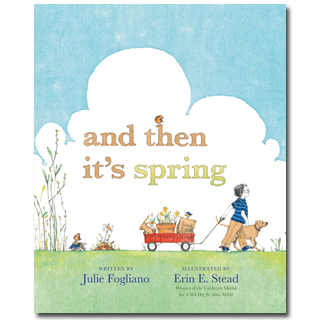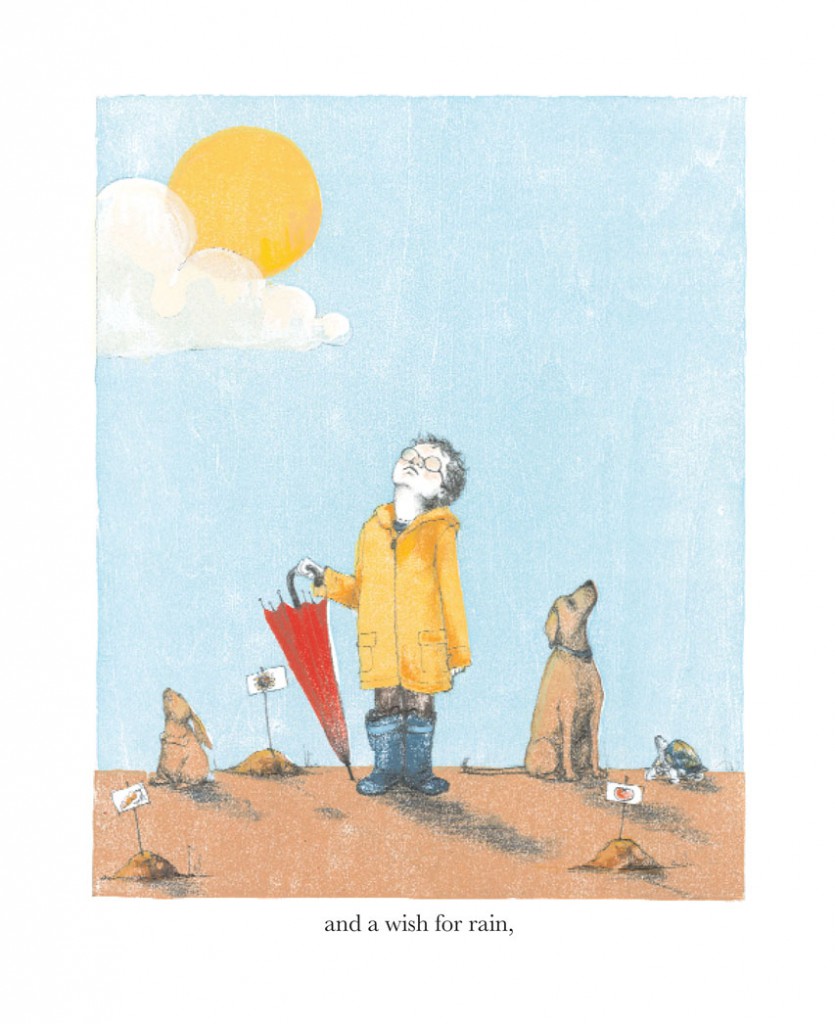
A FEW OTHER EVENTS FOR
MARCH 20:
- Happy birthday Mitsumasa Anno (Anno’s Counting Book), Lois Lowry (The Giver, Number the Stars), Ellen Conford (Jenny Archer series), Pamela Sargent (Child of Venus), and Louis Sachar (Holes).
- It’s the birth date of Fred Rogers (1928–2003) When a Pet Dies, and Shigeo Watanabe (1928–2006), Ice Cream Falling.
- In 1852, Harriet Beecher Stowe’s Uncle Tom’s Cabin is published. It was the best selling novel of the nineteenth century and is credited for fueling the American Civil War because of its anti-slavery message.
- It’s Rotten Sneaker Day. (Ugh!) Read Rotten Ralph by Jack Gantos, illustrated by Nicole Rubel.
It has been an unusually difficult winter in New England this year, with several feet of snow arriving in the region. Although my Bernese Mountain Dog Lance has enjoyed every flake, I find myself longing for the first day of spring.
That sense of joy, of the brown, dry earth coming to life has been brilliantly captured in our book of the day, Julie Fogliano’s And Then It’s Spring. A perfect book to use to explain cycles of life, or the seasons, to two- through eight-year-olds, the text begins “First you have brown, all around you have brown.” Then a young boy plants seeds and wishes for rain, until the color becomes “a hopeful, very possible sort of brown.” As the boy places more seeds in the earth, he worries about them, fearing that birds and bears might have taken them away. But, at the end of the story, just as the boy hoped, the brown earth has been replaced by green.
The simple, poetic text can be read again and again, and the illustrations by Erin E. Stead will bring readers back even more times. Like many others, I wondered what Erin would do in her first foray after winning the Caldecott Medal for A Sick Day for Amos McGee. In And Then It’s Spring, she has the perfect text for her strengths as an artist. She extends the words, bringing in other story lines about the antics of a dog, rabbit, turtle, and birds. She modulates color so that it slowly changes from dull brown to green in slow increments. She masterfully places spots of brighter color (a red scarf and mittens, or a wagon) to provide focal points in each scene. She creates believable characters and then uses them to bring sly humor into the art: the dog watches seeds that show a dog bone on the card above the hole; the rabbit peers at what should become carrot plants. And once again Erin shows that art in picture books doesn’t have to scream or yell—it can quietly and charmingly tell a story that draws readers in with its subtlety.
For those who enjoy paring fiction and nonfiction, this book works perfectly with Laura Vaccaro Seeger’s Green. Personally I haven’t seen a picture book since The Carrot Seed that so brilliantly explores the idea of life and hope coming out of a seed. Happy beginning of spring—I hope you can watch the color green come over your land and have a chance to read And Then It’s Spring to celebrate.
Here’s a page from And Then It’s Spring:
Originally posted March 20, 2012. Updated for 2024.














I just got this book a few days ago. Subtle is the right word for it. I look forward to reading it to several classes today! Another beautiful nonfiction book that would work great with it is A Seed is Sleepy. (It’s been unseasonably warm in Ohio, too!)
Dan: Thanks for the recommendation. We hit 80 yesterday — more like summer than spring.
What a gorgeous book, I love how delicate and simple the illustrations are. I’m a big fan of the Carrot Seed too.
Happy Spring, Anita! I’ll celebrate (even though it’s snowing as I write) by reading this lovely book again.
A warm friendly book with calm thoughtful movement through time, and the colors are a perfect match for the mood.
Wonderful art work.
I agree, Anita. Erin Stead’s art really brings this story together. So much brown! But what a beautiful world it turns out to be.